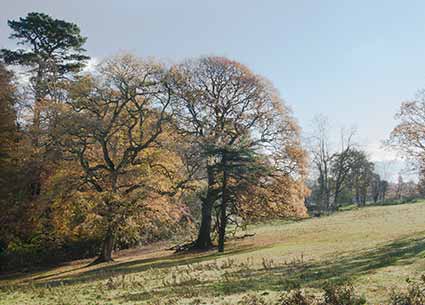Cuffnells – the middle years of the 19th century

estate grounds
By 1833, Cuffnells was owned by Sir Edward Poore, Bart., (1795-1838), of Rushall, Wiltshire, and his wife, Lady Agnes Poore.
A detailed, rather forthright, none too complimentary description of the grounds at around this time comes from JC Loudon's Gardener's Magazine:
‘Nature has done much for this place, in the variation of the ground, and in the distribution of some fine indigenous oak and beech trees, the remains of the forest. The house is well placed, and there is a magnificent conservatory attached to it, but with rather too opaque a roof, so that the trees planted in it, though they are tall, have not that vivid green, and strong healthy appearance, which they would have if the roof were entirely of glass. Neither do they flower freely, for the same reason.
The appearance round the house is unsatisfactory, for want of a terrace in front, and a lawn and pleasure-ground; in short, for a want of that appearance of art, and high finish, which ought always to accompany such a mansion. For these appendages there is every natural facility, and we know of few places that would be so much improved by their addition.
There is a naked shadeless walk which leads to a small flower-garden, a rosary, and the kitchen-garden. The flower-garden is surrounded by a low brick wall, on which are some fine Cape and Australian shrubs, which stand the winter without the slightest protection.
We noted down Acacia lophantha and armata; Plumbago, two specimens; Viburnum rugosum, several camellias, Escallonia montevidensis and rubra, Maurandya, Alstrœmeria, Hedychium, Agapanthus, Mesembryanthemum, &c. &c.
In the boundary hedge of the rosary were large myrtles, and a Callistemon lanceolatus, 15ft. high, which had been out ten years. Near the conservatory was a Rhododendron ponticum, 15 ft. high, the branches of which covered a space 39 yards in circumference; and, in a shubbery at the back of the kitchen-garden, were two or three fine specimens of liquidambar, deciduous cypress, catalpa, and large planes.
The effect of the yellow green foliage of the latter in these grounds is very striking as contrasted with the dark green of the magnificent oaks and hollies, which are so abundant in both places. This, and several circumstances of the kind, may afford important hints to landscape-gardeners in the distribution of trees’.
But by 1852 the exterior aspects of the property seem to have been considerably improved, for the British Gazetteer of that year contains a rather more conciliatory entry:
‘Situated near the centre of the New Forest; it possesses many peculiar advantages of scenery, and its bold irregularity of surface, finely adorned with majestic oaks and noble beech trees, present some beautiful landscape effects. The mansion stands on a rising ground embosomed in trees, and possesses all the characteristics of an English gentleman’s residence. It was some few years ago the residence of Sir George Rose, who was twice here honoured with visits from King George III and his Queen, Charlotte.
The house contains many handsome apartments, and is embellished with some remarkably fine portraits of the great men of the present and past age……’
Lady Agnes Poore continued at Cuffnells after her husband’s death in 1838, although the Rushall mansion was demolished at this time, and the estate broken up and sold.
In around 1847, Cuffnells was let to Eliza Powell who until the early 1840s had lived at the nearby Foxlease estate – Eliza remained at Cuffnells until at least 1851, together with son Henry and daughter Mary. But by 1855, she was back at Foxlease, and in the same year Cuffnells was advertised for sale by Lady Agnes.
Did Eliza’s re-purchase of Foxlease prompt the sale of Cuffnells, or did the impending sale of Cuffnells prompt the move back to Foxlease? Or maybe Eliza moved out of Cuffnells before 1855. These are puzzles still to be resolved.
Anyway, Cuffnells was purchased in 1856 by Jonathan and Anna Hargreaves, from whom on their deaths in 1862 and 1872, respectively, the estate passed to their son Reginald.
He brought to the old house by marriage, Alice Liddell, the inspiration for Lewis Carroll’s Alice in Wonderland.
And so the Alice story began.
Find out more about Cuffnells
References:
Lyndhurst Historical Society publications: Roy Jackman
Lyndhurst – A Brief History and Guide: Georgina Babey and Peter Roberts
JC Loudon's Gardener's Magazine
British Gazetteer, 1852
Local Directories, Census records, Cuffnells sale posters and ‘Of what I remember of Lyndhurst and the neighbourhood nearly fifty years ago: Mrs. R. Bowden-Smith’, all courtesy of the Christopher Tower New Forest Reference Library
More links
Other related links
Search this site

Sadly, 58 animals were killed - 35 ponies, 13 cows, 8 donkeys and 2 sheep, whilst a further 32 were injured - 3 pigs, 9 donkeys, 11 cows and 9 ponies.
(Forty-three accidents occurred in daylight, 15 at twilight and 101 in the dark. Twenty-seven accidents were not reported by the driver involved).
Here's just one horrific example - Three donkeys killed in collision with van at notorious New Forest blackspot (Advertiser and Times)

